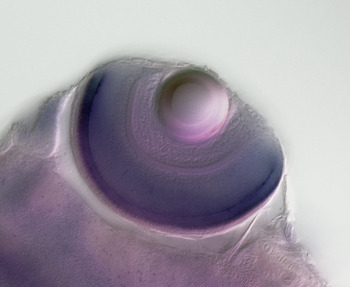This decommissioned ERA site remains active temporarily to support our final migration steps to https://ualberta.scholaris.ca, ERA's new home. All new collections and items, including Spring 2025 theses, are at that site. For assistance, please contact erahelp@ualberta.ca.
- 288 views
- 199 downloads
V-eye-olet
-
- Author(s) / Creator(s)
-
Human mutations in the gene unc119 result in retinal degeneration that can eventually lead to colour and night vision loss and in extreme cases, blindness. Yet, it isn't known how unc119 functions in the retina and why mutations cause retinal disease. The goal of my project is to use the vertebrate model organism zebrafish to study the function of unc119 in the retina. To confirm that the zebrafish version of unc119 is active in the same cell types as the human version, I performed a technique called in situ hybridization. This method allows the detection of the mRNA product of the unc119 gene in various tissues. Areas that have dark purple staining are indicative of tissues that unc119 is active. This photo is a cross-section of the zebrafish eye, where staining is observed in the most outer most section of the retina, which is precisely where human unc119 is active. This evidence supports our hypothesis that zebrafish unc119 functions identically to human unc119 and that this work can directly be translated into understanding the role of human unc119. // Program of Study: PhD // Faculty/Department: Biological Sciences // Place of creation: University of Alberta // Award: Semi-finalist Prize, Images of Research Competition 2017
-
- Date created
- 2017-01-01
-
- Subjects / Keywords
-
- Type of Item
- Image
-
- License
- Attribution 4.0 International
